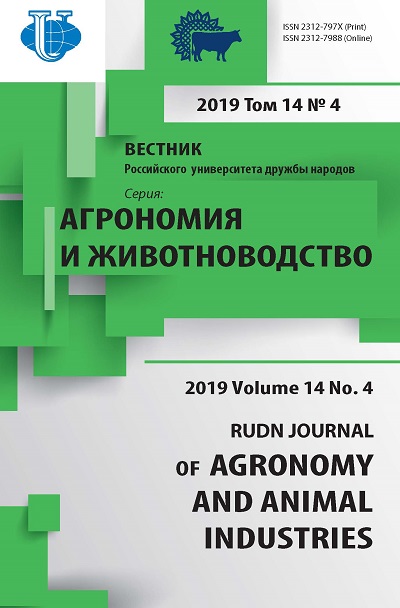Biocidal activity of the extracts of Vernonia amygdalina against ticks responsible for livestock diseases
- Authors: Bisusa M.1, Bagalwa M.1,2, Zirirane D.N2, Mushagalusa N.2,3, Karume K.2,4
-
Affiliations:
- Research Center in Natural Sciences
- Evangelical University in Africa
- Higher Institute of Rural Development
- Goma Volcanological Observatory
- Issue: Vol 14, No 4 (2019)
- Pages: 481-491
- Section: Veterinary science
- URL: https://agrojournal.rudn.ru/agronomy/article/view/19532
- DOI: https://doi.org/10.22363/2312-797X-2019-14-4-481-491
- ID: 19532
Cite item
Full Text
Abstract
About the authors
Muhimuzi Bisusa
Research Center in Natural Sciences
Email: bisusamuhimuzi@gmail.com
Researcher in Environmental Sciences, Head of Veterinary Entomology Laboratory, Research Associate D.S. Bukavu, Democratic Republic of Congo
Mashimango Bagalwa
Research Center in Natural Sciences; Evangelical University in Africa
Email: mashibagalwa@gmail.com
PhD at Makerere University, Head of the Malaria Laboratory, Researcher, NSRF, Research Center in Natural Sciences, CRSN-Lwiro; Research Associate, Evangelical University in Africa, Faculty of Agronomy and Environment D.S. Bukavu, Democratic Republic of Congo
Dieudonné N Zirirane
Evangelical University in Africa
Email: didozirirane@gmail.com
Master's degree in Environment, Faculty of Agronomy Bukavu, Democratic Republic of Congo
Nachigera Mushagalusa
Evangelical University in Africa; Higher Institute of Rural Development
Email: mushagalusa2007@yahoo.fr
PhD, Faculty of Agronomy; Higher Institute of Rural Development Bukavu, Democratic Republic of Congo
Katcho Karume
Evangelical University in Africa; Goma Volcanological Observatory
Email: kkatcho@yahoo.com
PhD, Goma Volcanic Observatory, Department of Geochemistry and Environment; Ordinary Professor, Dean of Agronomy Faculty Goma, North Kivu, Democratic Republic of Congo
References
- Gitau GK, Perry BD, McDermont JJ. The incidence, morbidity and mortality due to Theileria parva infections in smallholder dairy farms in Muranga District, Kenya. Prev Vet Med. 1999; 39(1):65-79. doi: 10.1016/S0167-5877(98)00137-8
- Sika FK, Masunga M, Wabo B. Recherche sur les tiques et les maladies qu’elles transmettent au bétail dans le Kivu d’altitude. Document de travail, CRSN-LWIRO, 1986. 36p.
- Makumyaviri AM, Habimana M. Prévalence de la theilériose bovine à Theileriaparvasur les plateaux d’Itombwe, Centre Est Zaïre. Revue Méd Vét. 1993. 144(5):415-418.
- Bagalwa M, Masunga M, Balagizi K, Ntumba K. Epidémiologie des maladies gastro-intestinales du bétail et inventaire des mollusques dans les hauts Plateaux d’Uvira, Est du Zaire. Tropicultura. 1996; 14(4):129-133.
- Bisusa M, Amzati S, Bagalwa M. Distribution altitudinale actuelle des tiques (Acarina-Ixodidae) chez les bovins élevés dans les groupements de Bugorhe et Irhambi-Katana en territoire de Kabare, Sud-Kivu, RDC. Annales de l’UEA, Numéro spécial sur l’environnement. 2014; 69-80.
- Sofowora A. Plantes médicinales et médecine traditionnelle d’Afrique. Paris: Karthala; 1996.
- Chifundera K, Baluku B, Mashimango B. Phytochemical screening and molluscicidal potency of some Zairian medicinal plants. Pharmacological Research. 1993; 28(4):333-340. doi: 10.1006/phrs.1993.1135
- Pamo ET, Tapondjou LA, Tendonkeng F, Nzogang JF, Djoukeng J, Ngandeu F, Kana JR. Effet des huiles essentielles des feuilles et des extrémités fleuries de Cupressus lusitanica sur la tique (Rhipicephalus lunulatus) à L'ouest-Cameroun. Journal of the Cameroon Academy of Sciences. 2003; 3(3):169-175.
- Walker JB, Keirans JE, Horak IG. The genus Rhipicephalus (Acari, Ixodidae): A guide to the brown ticks of the world. London: Cambridge University Press; 2002.
- Kabaru JM, Gichia L. Insecticidal activity of extracts derived from different parts of the mangrove tree Rhizophora mucronata (Rhizophoraceae) LAM against three arthropods. African Journal of Science and Technology. 2001; 2(2):44-49. doi: 10.4314/ajst.v2i2.44668
- Busvine JR. A critical review of the techniques for testing insecticides. 2nd ed. England: Commonweath Agricultural Bureau; 1971.
- Erasto P, Grierson DS, Afoloyan AJ. Bioactive sesquiterpene lactone from the leaves of Vernonia amygdalina. Journal of Ethnopharmacology. 2006; 106(1):117-120. doi: 10.1016/j.jep.2005.12.016
- Attia S, Grissa KL, Ghrabi-Gammar Z, Mailleux AC, Lognay G, Le Goff G, Hance T. Contrôle de Tetranychusurticaepar les extraits de plantes en vergers d’agrumes. Entomologie faunistique - Faunistic Entomology. 2011; 63(4):229-235.
- Hanifah AL, Awang SH, Ming HT, Abidin SZ, Omar MH. Acaricidal activity of Cymbopogon citrates and Azadirachta indica against house dust mites. Asian Pacific Journal of Tropical Biomedicine. 2011; 1(5):365-369. doi: 10.1016/S2221-1691(11)60081-6
- Basabose K, Bagalwa M, Chifundera K. Anophelinocidal activity of volatile oil from Tagetes minuta L. (Asteraceae). Tropicultura. 1997; 15(1):8-9.
- Djeridane A, Brunel JM, Vidal N, Yousfi M, Ajandouz EH, Stocker P. Inhibition of porcine liver carboxylesterase by a new flavones glucoside isolated from Deverr ascoparia. ChemicoBiological Interactions. 2008; 172(1):22-26. doi: 10.1016/j.cbi.2007.11.008
- Marna LC, Gikaru G, Ajayi F. Les avantages des pesticides naturels. Agriculteurs Africains. 1990. 158 p.
- Chiasson H, Beloin N. Les huiles essentielles, des biopesticides “Nouveau genre”. Bulletin de la Société d’Entomologie du Québec Antennae. 2007; 14(1):3-6.
- Adjou ES, Soumanou MM. Efficacité des extraits de plantes dans la lutte contre les moisissures toxinogènes isolées de l'arachide en post-récolte au Bénin. J Appl Biosci. 2013; 70:5555- 5566. doi: 10.4314/jab.v70i1.98755
- Adehan SB, Biguezoton A, Adakal H, Dossa F, Dougnon TJ, Youssao E, Sessou P, Aboh AB, Youssao AKI, Assogba N, Mensah GA, Madder M, Farougou S. Acaricidal activity of ethanolic and volatile extracts of the leaves of selected plants used in Veterinary Pharmacopeia on the larvae of Rhipicephalus microplus in Benin. Alex J Vet Sci. 2016; 49(1):1-11. doi: 10.5455/ajvs.216241
Supplementary files















